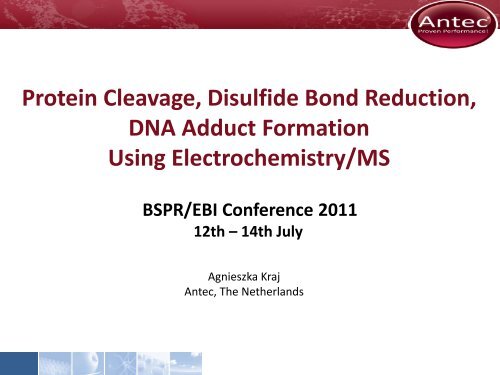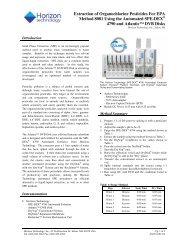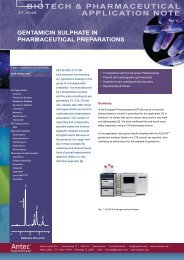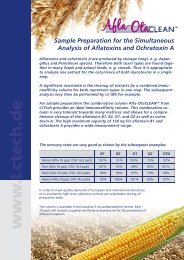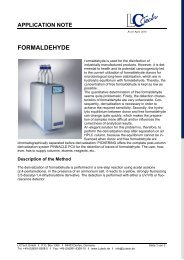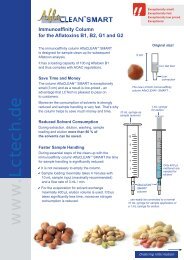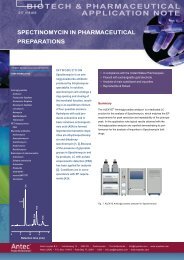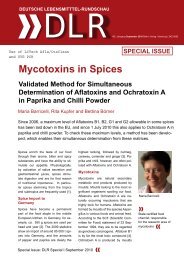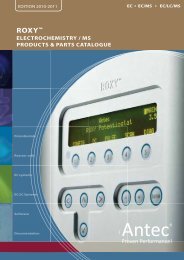Electrochemical disulfide bond reduction
Electrochemical disulfide bond reduction
Electrochemical disulfide bond reduction
You also want an ePaper? Increase the reach of your titles
YUMPU automatically turns print PDFs into web optimized ePapers that Google loves.
Protein Cleavage, Disulfide Bond Reduction,<br />
DNA Adduct Formation<br />
Using Electrochemistry/MS<br />
BSPR/EBI Conference 2011<br />
12th – 14th July<br />
Agnieszka Kraj<br />
Antec, The Netherlands
Outline<br />
• Applications overview<br />
• Principle of Electrochemistry<br />
• Reactions<br />
• Instrumentation<br />
• Electrochemistry in Proteomics<br />
• Conclusions
Application Areas Electrochemistry/MS<br />
Oxidative<br />
tagging of<br />
proteins<br />
Disulfide <strong>bond</strong><br />
<strong>reduction</strong><br />
Peptide <strong>bond</strong><br />
cleavage<br />
Drug ̶ ̶ protein<br />
binding<br />
Electrochemistry<br />
Proteomics<br />
upfront MS<br />
Desalting<br />
Drug<br />
metabolism<br />
Metabolite<br />
synthesis<br />
Signal<br />
enhancement<br />
in MS<br />
Oxidative<br />
damage of<br />
DNA
Principle of Electrochemistry (EC) upfront MS<br />
Reduction<br />
Oxidation
<strong>Electrochemical</strong>ly Oxidizable Amino Acid<br />
Amino acid Functional group Oxidized forms, with mass change<br />
Tyrosine<br />
phenol<br />
quinol, +16 Da<br />
quinone, +14Da<br />
Tryptophan<br />
indole<br />
indolol, +16 Da<br />
indolone, +14Da<br />
Cysteine<br />
Methionine<br />
thiol<br />
sulfenic acid, +16 Da sulfinic acid, +32Da sulfonic acid, +48 Da<br />
methylthioether<br />
methylsulfoxide, + 16 Da<br />
methylsulfone, + 32 Da
Electrochemistry (EC) upfront MS<br />
Instrumental set-up
Electrochemistry in Proteomics<br />
• peptide <strong>bond</strong> cleavage<br />
• <strong>disulfide</strong> <strong>bond</strong> <strong>reduction</strong><br />
• surface oxidation<br />
• desalting
Mechanism of cleavage after Y and W<br />
Tyrosine containing peptides: 1000mV<br />
Tryptophan containing peptides: 800mV<br />
Oxidation and cleavage pathways are pH dependent:<br />
• oxidation yield decreases with increasing pH<br />
• cleavage products formed only in acidic and neutral conditions<br />
J. Roeser et al., Anal. Chem., 2010, 82 (18), 7556
Cleavage of Angiotensin I (DRVYIHPFHL)<br />
ADVANTAGES:<br />
1) …alternative to enzymatic digestion<br />
by electro-chemical push button<br />
reaction in seconds!<br />
2) clean, no enzymes, no non-specific<br />
cleavage, no auto-digestion, etc.<br />
CURRENT STATUS:<br />
1) cleavage of big proteins is under<br />
development,<br />
2) optimization to increase the<br />
reaction yield.
<strong>Electrochemical</strong> Disulfide Bond Reduction
<strong>Electrochemical</strong> <strong>disulfide</strong> <strong>bond</strong> <strong>reduction</strong><br />
Insulin<br />
Chain B<br />
Non reduced<br />
Cell OFF<br />
Chain B<br />
Reduced<br />
Cell ON<br />
Chain A
<strong>Electrochemical</strong> Reduction of Lactalbumin<br />
<strong>Electrochemical</strong> <strong>reduction</strong> of the protein results in shift of charge state<br />
distribution suggesting conformational change of protein (S-S bridges <strong>reduction</strong>).
<strong>Electrochemical</strong> <strong>disulfide</strong> <strong>bond</strong> <strong>reduction</strong><br />
• on-line, electrochemical <strong>disulfide</strong><br />
<strong>bond</strong> <strong>reduction</strong> with DESI MS<br />
• identification of <strong>disulfide</strong> containing<br />
peptides from enzymatic digestion<br />
mixture<br />
• derivatization of thiols by selenamid<br />
• charge state distribution in proteins<br />
(native vs. reduced)<br />
Zhang et al., J. Proteome Res., 2011, 10, 1293
<strong>Electrochemical</strong> Desalting of Proteins<br />
Poster 42,<br />
Online <strong>Electrochemical</strong> Desalting of Proteins<br />
Mohamed Benama<br />
0 V 2.8 V<br />
Deconvoluted MS at 0V and 2.8V showing protein desalting.<br />
correspond to [Na + + K + ] combination<br />
correspond to background formylation of the protein
Relative Abundance (%)<br />
<strong>Electrochemical</strong> Oxidation as a Surface Mapping<br />
Probe of Higher Order Protein Structure<br />
McClintock et al., Anal. Chem. 2008, 80, 3304<br />
Lysozyme NMR structure (1E8L, model 6) showing surface with<br />
underlying secondary structure, <strong>disulfide</strong>s, and substrate binding<br />
site<br />
Lysozyme FT-MS spectra showing slight over-oxidation at +2.1V.<br />
Satellite peaks present in spectra may be due to sulfate adducts.<br />
Mass/Charge
Electrochemistry in Genomics<br />
DNA, nucleosides, etc.
Electrochemistry in Genomics
intensity / maxiumum intensity<br />
intensity<br />
/ maxiumum intensity<br />
intensity / maxiumum intensity<br />
intensity<br />
/ maxiu<br />
0.2<br />
Electrochemistry in Genomics<br />
0<br />
0 500 1000<br />
0.4<br />
... acetaminophen<br />
... guanosine<br />
1500 2000 2500<br />
E [mV]<br />
3000<br />
1.0<br />
0.8<br />
B<br />
1.0<br />
0.8<br />
... acetaminophen dimer<br />
... guanosine dimer<br />
... adduct<br />
0.6<br />
0.4<br />
0.2<br />
... acetaminophen<br />
... guanosine<br />
0.6<br />
0.4<br />
0.2<br />
0<br />
1.0<br />
0.8<br />
0.6<br />
0.4<br />
0.2<br />
0<br />
0 500 1000<br />
1500 2000 2500<br />
E [mV]<br />
3000<br />
... acetaminophen dimer<br />
Guanosine C<br />
... guanosine dimer + APAP<br />
E < 1200mV<br />
... adduct<br />
Guanosine + APAP<br />
0 500 1000<br />
1500 2000 2500<br />
E [mV]<br />
3000<br />
0<br />
1200mV < E < 1800mV<br />
APAP<br />
Guanosine + APAP 1800mV < E<br />
0 500 1000<br />
E < 1200 mV<br />
(1) guanosine + APAP<br />
no product detected<br />
(2) guanosine + APAP<br />
1500 2000 2500<br />
E [mV]<br />
1200 mV < E < 1600 mV<br />
— APAP<br />
1600 mV < E<br />
(3) guanosine + APAP – APAP<br />
+ Guanosine – Guanosine<br />
+ APAP – Guanosine<br />
3000<br />
no product detected<br />
APAP-APAP<br />
APAP-APAP<br />
+ guanosine-guanosine<br />
+ APAP – guanosine
Electrochemistry in Genomics
Summary<br />
• EC/MS shows great potential in proteomics:<br />
• <strong>disulfide</strong> <strong>bond</strong> <strong>reduction</strong><br />
• protein (), peptide <strong>bond</strong> cleavage<br />
• surface oxidation<br />
• desalting<br />
• drug – protein binding<br />
• EC/MS is used successfully in mimicking of DNA damage and covalent<br />
adduct formation<br />
EC/MS represents a powerful technique for fast<br />
study of natures REDOX reactions.<br />
22
Acknowledgements:<br />
Mohamed Benama<br />
University of Bristol<br />
Simon Lambert


